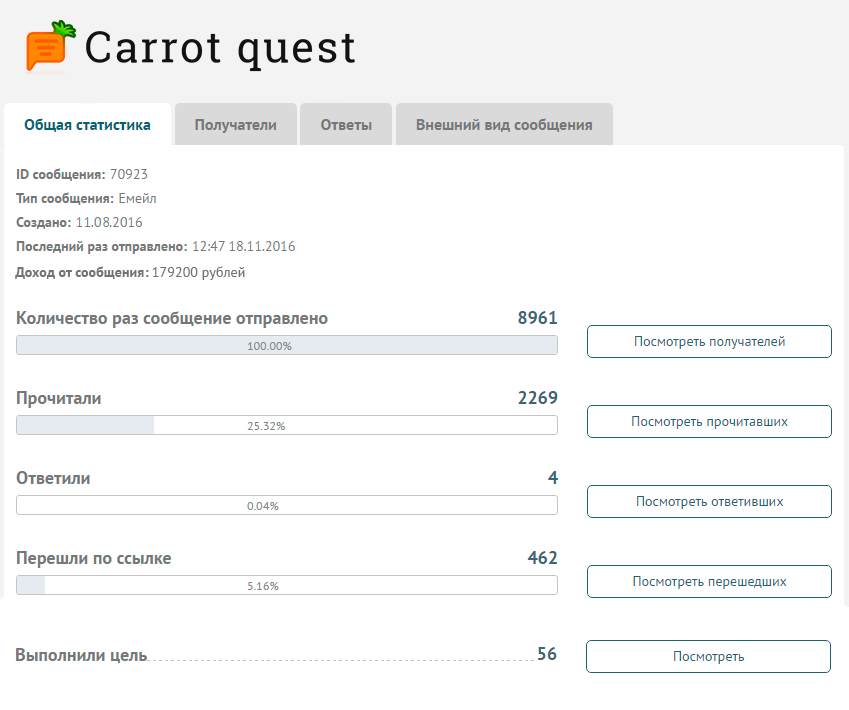Marketing email marketing: the main metric that you safely forgot about

We analyze the statistics of email-mailings and pop-up windows, why the majority do not know the real effect of the letter and how companies lose customers on this. We will share a cool approach in the analysis of mailings, so that you can assess the impact of each letter on sales (or other targeted actions).
The effectiveness of email marketing can be measured using basic metrics. You know them well:
- Number of subscribers;
- The rate of delivered letters;
- The rate of open letters;
- CTR links in the letters or the percentage of transitions from the letter to the site;
- Conversion rate;
- Unsubscribe index;
- The spam tag rate.
- We often hear that we usually look at the number of discoveries and clicks in letters. And this is a problem!
All standard indicators indicate that the audience of the letter is chosen correctly or incorrectly, receives interesting content and actively interacts with it (clicks on links). But these figures do not say a word about sales and other actions, which, in fact, are the main goal of your email campaign.
Let's take an example
how these figures can mislead you.
')
Imagine that you are an online store and do a newsletter for your customers. You send two kinds of letters to the same audience. The average check you have is 3200 rubles. Which letter would you consider more effective and use further?

Obviously, the first one does the job better. But is everything so simple? Let's remember that the main goal of any business is sales and every action of the company should be aimed at achieving this goal. Therefore, add another parameter:

What do you say now? It seems that the second letter is still more important for your company. Look, it brings 3 times more money than the first!
Why did this happen? Perhaps in the first letter you told the story or intrigued, thus forcing you to open and click on the links. But the letter did not activate the user in the purchase. The second letter was more successful in terms of sales, although the ultimate goal of these letters was the same.
This can be compared with contextual advertising. You do not celebrate, if you have collected a lot of clicks, but you have not sold anything. The effectiveness of such advertising is zero. So with the letters.
Think how often you are deceived by looking at classic mailing list metrics? Some companies are wrong all the time - spend their money and time, but do not make a profit.
Naturally, the read message is not an end in itself. Behind it is one of the target actions that you want to push to make the user:
- to call
- subscribe to the newsletter
- submit your application,
- buy, etc.
Measure how many people reach the goal . Achieving the goal is one of the main indicators for evaluating the effectiveness of writing. Otherwise, it turns into a simple creative that does not lead to anything.

Popup Efficiency
The situation is similar with pop-ups. What key performance indicator do you measure? Most likely, this is the number of clicks.
Clicking on the link in the pop-up, a person gets to the necessary page, but no one knows what will happen after that (with rare exception). It turns out that clicking on the link does not mean that he will buy. It’s frivolous to talk about the effectiveness of the popup, because you never had enough money in your piggy bank.
It may seem that this is only relevant for online stores, but it is important for everyone.
Trust can be any action, as bringing money, and just important for you. For example: the use of a key function in the service.
How to set up the correct analytics of letters and pop-up windows
We analyzed a lot of email newsletters and realized that the target action after reading the message is the main metric for each letter. Therefore, in the Carrot Quest service, we launched this feature so that you could keep the effectiveness of your messages under control without the help of programmers and complex settings.
Step 1. Set a goal
Determine what effect your email should have, what action it targets (what do you expect from the user after reading)? Select the target action from the drop-down list, where all the standard and customized events are collected.

Goals can be monitored if you have previously configured the collection of information about the actions of each user on the site - what he did (bought, subscribed, viewed the product, etc.). After all, its action is the goal. You can customize this without the help of a programmer.
Step 2. Determine the value of the goal.
Some user actions bring money to your company. If the message leads to such actions, assign its value.
The logic is as follows:
The user saw the message-> made the target action-> paid you X rubles. The goal value for this message is X rubles.
Also, the value of the goal can be determined at intermediate stages, for example, the user left his contact - became the lead. Knowing the conversion from leads to a paying customer, you assign the value of the contact left - X rubles.
The value of the goal can be set manually (if achieving the goal leads to a fixed profit or the average check is calculated) or automatically through the property (when the purchase amount is different each time).

Example:
- You have Landing for the sale of a single product. Landing application brings you 500 rubles. The value of the goal in this case will be 500 rubles. This value can be specified manually.
If you have a web service with a subscription, then surely there is a payment event (or order). Add a property to this event - the amount of the payment and set it as a target.
If you want to push the lead to subscribe to your newsletter using a message, you can not determine the value of the goal, because target action does not bring direct profit.
If the monetary value of the goal cannot be determined, it is still worth tracking the goal, because it directly reflects the effectiveness of your marketing - the user did what you wanted from him.
After you have determined the value of the goal, in the statistics of this auto-message you will see the number of users who have achieved the goal and the amount earned.
Step 3. Specify the speed to achieve the goal.
It is very important to measure the fulfillment of the goal correctly. If the user read the message and made the target action in too long a period of time, it is wrong to think that it was this message that affected his action.
For example, if a user read a letter and bought 2 months after receiving a letter, it is unlikely that the letter influenced his decision to purchase.
Therefore, it is important to measure the effectiveness of a target for a fixed time.

The minimum possible time during which you can track the achievement of the goal, 1 minute, maximum - 30 days. Choose a time depending on your situation.
Example:
For a trigger letter, it is logical to set the speed of achieving the goal equal to a couple of days.
For a pop-up, the speed of reaching the goal is unlikely to exceed several hours.
Conclusion:
Score goals can lead to unexpected results. It may be that, despite the high rate of discoveries, the letter does not lead the user to the target action. This means that more attention should be paid to this letter. Perhaps it can be completely disabled, or try to change, to still bring the user to the target action.

There is no easier way to track this metric than in Carrot Quest . All the old methods are associated with complex settings, with the help of a programmer, a bunch of utm-tags, etc. In Carrot Quest, you can do everything yourself without spending a lot of time. Try it yourself and rate 14 days for free.
With pleasure, Carrot Quest, a service that automatically collects information about each visitor to your site and helps to guide him to purchase, both manually and automatically.
Source: https://habr.com/ru/post/323322/
All Articles